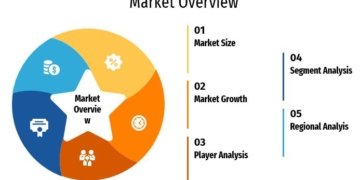The global radar market is projected for substantial growth, poised to reach USD 85.6 billion by 2035 from an estimated USD 42.1 billion in 2025, demonstrating a robust Compound Annual Growth Rate (CAGR) of 7.8% during the forecast period. This significant expansion is propelled by ongoing innovations in solid-state radar, synthetic aperture radar (SAR), and multifunctional phased array radar. Additionally, the increasing incorporation of machine learning and artificial intelligence (AI) into these systems is enhancing detection accuracy, enabling real-time analytics, and improving overall operational efficiency across diverse applications.
Exhaustive Market Report: A Complete Study
https://www.futuremarketinsights.com/reports/radar-market
Sensing the Future: Driving Forces and Core Applications
Radar systems are integral to contemporary security, transportation, scientific research, and military defense. They are crucial for surveillance, missile detection, and battlefield reconnaissance in defense applications. In the transportation sector, radar technology is revolutionizing safety through collision avoidance systems, adaptive cruise control, and advanced traffic monitoring. Aerospace navigation relies on sophisticated radar for air traffic control, while meteorology utilizes the technology for precise weather forecasting and tracking of severe weather patterns.
Several key factors are driving the industry’s growth. The rising adoption of radar in automotive driver assistance systems is significantly enhancing road safety and accelerating the development of autonomous vehicles. Globally, defense agencies are increasing investments in next-generation radar technology to advance situational awareness and counter dynamic security challenges. Furthermore, the growing frequency of extreme weather conditions is escalating the need for advanced weather and environmental surveillance systems. The integration of AI system analytics is also optimizing data storage, management, and timely processing, further boosting system adoption.
Segment Spotlight: Land, Naval, Short-Range, and Medium-Range Dominance
By platform, the Land segment is estimated to command a significant industry share of 57% in 2025, propelled by the demand for ground-based surveillance, air defense systems, and border security. This growth is driven by increased geopolitical tensions and cross-border threats, prompting countries to invest in advanced military and homeland security systems.
The Naval segment has emerged as a substantial contributor, with a 43% share by 2025, driven by rising demand for shipborne, sea-based surveillance, and anti-submarine warfare. Global navies are expanding their fleets and modernizing defense capabilities, leading to a surge in demand for multi-mode long-range naval radars.
In terms of range, the Short-Range section is projected to hold an industry share of 48% in 2025, driven by the growing demand for ground-based surveillance, automotive, and urban security radars. These systems are commonly used in border security, perimeter surveillance, UAV detection, and autonomous vehicle collision avoidance. The Medium-Range segment is projected to dominate the industry with a 52% share by 2025, with primary applications in air defense, missile tracking, and military surveillance, including battlefield surveillance and air traffic control.
Navigating Challenges: Cost, Regulations, and Cybersecurity
Despite the high growth trajectory, the radar market faces several challenges. The high cost of developing and implementing sophisticated radar systems can hinder adoption, particularly for small-scale applications. Additionally, regulatory constraints regarding frequency spectrum allocation can impede system deployment. The increasing threat of electronic warfare capabilities that interfere with radar operation, coupled with growing cybersecurity threats, also poses significant risks for both commercial and defense consumers. Overcoming these challenges through improved cybersecurity methods and economical manufacturing processes will be essential for sustained industry growth.
Future Trends: Quantum, AI, and Miniaturization
Technological innovations and dynamic industry trends are continuously shaping radar development. The integration of AI-driven analytics, 5G-driven transmission, and quantum technology is expected to significantly minimize detection time and enhance data processing speed. Furthermore, advancements in miniaturized and low-power systems are creating new opportunities for portable and drone-based applications. As governments increase investments in defense modernization, intelligent transportation infrastructure, and climate monitoring, the industry is poised for substantial expansion in the coming decade, reshaping global security, mobility, and scientific exploration.
Competitive Landscape: Leaders and Innovators
The radar industry is highly competitive, driven by growing demand across diverse sectors including defense, aerospace, automotive, weather monitoring, and industrial automation. The market is characterized by the dominance of a few key companies with strong R&D portfolios, significant defense contracts, and innovative technological achievements. Leading players in this market include:
Lockheed Martin Corporation: A global leader providing advanced radar systems for defense and aerospace, including high-precision surveillance and missile defense.
Raytheon Technologies: Builds complex radar solutions for military, weather forecasting, and air traffic control, at the forefront of AI-based radar analytics.
Northrop Grumman Corporation: Specializes in next-generation radar technology for stealth aircraft, airborne surveillance, and integrated defense systems.
Thales Group: Offers a wide array of AI-enabled tracking and threat detection systems for ground-based and naval solutions.
BAE Systems: Specializes in military and naval defense systems, and also provides radar solutions for automotive self-driving car applications.
Other key players shaping the competitive landscape include Saab AB, Leonardo S.p.A., Indra Sistemas S.A., Mitsubishi Electric Corporation, and Honeywell International Inc. These organizations are actively pursuing product diversification and portfolio expansion, emphasizing the integration of AI, machine learning, and edge computing to improve real-time data processing and decision-making, ensuring their leadership in this rapidly evolving market.
Get Ahead with Our Report: Request Your Sample Now!
https://www.futuremarketinsights.com/reports/sample/rep-gb-267
Discover trends shaping similar markets-read our related reports.
Radar Security Market
https://www.futuremarketinsights.com/reports/radar-security-market
Marine Radar Market
https://www.futuremarketinsights.com/reports/marine-radar-market
Vehicle Radar Test System Market
https://www.futuremarketinsights.com/reports/vehicle-radar-test-system-market
Future Market Insights Inc.
Christiana Corporate, 200 Continental Drive,
Suite 401, Newark, Delaware – 19713, USA
T: +1-845-579-5705
For Sales Enquiries: sales@futuremarketinsights.com
Website: https://www.futuremarketinsights.com
Future Market Insights, Inc. (ESOMAR certified, recipient of the Stevie Award, and a member of the Greater New York Chamber of Commerce) offers profound insights into the driving factors that are boosting demand in the market. FMI stands as the leading global provider of market intelligence, advisory services, consulting, and events for the Packaging, Food and Beverage, Consumer Technology, Healthcare, Industrial, and Chemicals markets. With a vast team of 400 analysts worldwide, FMI provides global, regional, and local expertise on diverse domains and industry trends across more than 110 countries.
This release was published on openPR.


















